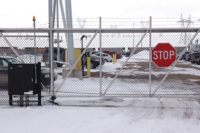Designing an access control system often starts with the reader technology. But in some environments, that is the least of your concerns. Harsh environments can mean anything from extreme temperature (hot or cold), to dusty, dirty, gaseous, chemical and beyond. And while cards and readers may work just fine in those conditions, that is anything but a given. There are far more things to consider in the design of systems for these special circumstances.
“Harsh environments can involve temperature, humidity, aggressive gasses or particulates,” says Brad Aikin, product manager for commercial electronic locks, Ingersoll Rand, Carmel, Ind. “Aggressive or acidic gasses such as those found in paint booths at automotive facilities can attack mechanical components and eat away at finishes and circuit boards. Tire manufacturing involves large particulates of rubber dust. Even a marshmallow plant has powdered marshmallow particulates all over the place.”
Locations near the ocean with the salt air and humidity present different but equally harsh conditions for electronic access control systems. And even environments like hospitals can actually be considered harsh, due to the chemicals used to clean.
“A harsh environment for us is outside in the weather or in industrial environments such as coolers for large commissary facilities or pharmaceutical plants with lots of chemicals and splash downs,” says integrator Chris Olson, manager of engineering services, Intertech Security, Pittsburgh.
Electronic access control may be fundamentally the same on any facility, but harsh environments require special considerations, such as making sure devices are water and dust sealed and that all the other components are designed or rated for that type of environment.
Reader Requirements
Proximity and contactless smart card readers are logical choices for many harsh environment conditions.
“Proximity is the most forgiving of the technologies as far as weather applications as well as physical constraints,” says Rick Current, senior sales engineer, Matrix Systems Inc., Miamisburg, Ohio.
Dave Adams, senior product marketing manager, HID Global, Irvine, Calif., explains, “Contactless readers by design are well suited in harsh environments because there is nothing to run the card through and nothing to wear out. We use potting material for the majority of our readers, which seals it from any kind of water penetration. And as far as salt and other outdoor environments, the material we use is impervious to it.”
Keypads can also be good choices, particularly those utilizing Piezo technology, which has no moving parts. But there are times when a technology must be used — either for economic or security reasons — that is not inherently good for harsh environments.
“Proximity is better, but a lot of times the customer doesn’t have a choice,” Aikin says. “We have two types of magnetic readers for our integrated locks. One is a swipe reader, which is generally more user friendly but the read head is more exposed. Our insert reader is a little more protective of the electronic components and is preferred in installations such as a military base located in the desert with sand particulates.”
Systems that incorporate LED displays can have trouble in extreme cold, says Richard Sedivy, director of marketing and regulatory affairs, DoorKing, Inglewood, Calif. “We have backlit displays with moving characters and that type of display may freeze up in extreme cold. For those situations we have heater kits that can overcome that.”
Many manufacturers of varied technologies offer heaters, coolers or enclosures to protect their equipment from extreme environments, and these can offer a reasonable solution when those technologies are required or preferred.
Biometrics is a good example of a technology that may be required (per government mandate or recommendation) but not suited to the environment.
“Hand readers have been used in outdoor environments where a lot of other biometrics have not, because we have special enclosures for them,” says Jennifer Toscano, marketing manager, Ingersoll Rand Security Technologies, Sunnyvale, Calif.
Biometrics are not just a potentially sensitive technology environmentally, the environment can also affect the ability to read the biometric itself, making the choice of technology critical. Certain environments such as those with a lot of dirt or grease can affect a person’s fingerprint readability, for example. And some chemicals can actually destroy the external print entirely.
Hand geometry looks at several points of the hand, making it more forgiving of dirt and dust. But other technologies have emerged recently that are also highly useful in harsh environments. The multispectral imaging technology employed by Lumidigm, Albuquerque, N.M., was specifically designed for both hard-to-read prints (even through latex gloves) and harsh weather environments.
“The integrator’s view of what can be used outside has traditionally incorporated card readers and keypads but not biometrics because they have tried them outside and they failed miserably,” says Bill Spence, vice president of transaction systems, Lumidigm. “What we had for many years was indoor technology that we put outside then tried to protect from the elements.” Multi-spectral technology looks beneath the outer layer of the skin to the sub dermal layer, and is also impervious to temperature extremes.
Beyond the Reader
While choosing the right reader technology is critical, it is far from the only piece of the puzzle when it comes to designing for a harsh environment.
“The biggest thing I see is the hardware element,” says integrator Brent Franklin, president, Unlimited Technology Inc., Chester Springs, Pa. “That is what we most often see as the failure point. A lot of times we will go into a site and the door hardware is all rusted. The hardware has failed because no one put the right hardware on it to begin with.”
From hinges to handles to locks to door switches, contacts and request to exit buttons, the “meat” of harsh environment resistant access control systems is in the components.
“We have done a lot of installations with heavy chemicals in the air,” Franklin says. “Taking the time to look at that whole opening is really the key to the success of the entire project.”
Manufacturers generally provide ratings on their products based on whatever standards apply. Look for manufacturers that provide individual components rated and built to stand up to these environments.
“We focus on the switch side of the business rather than readers,” says David Price, marketing manager, Camden Door Controls Inc., Toronto. “The design of the product itself has to be able to withstand the environment. You want to have robust switches that can take the temperature extremes. You have to look at the rating of the contact, the design of the faceplate and even the type of button if you want to have an indestructible switch that isn’t prone to temperature or moisture extremes.”
“Dortronics manufactures the electric locking devices including mag locks, electric strikes and request to exit,” says Bryan Sanderford, national sales manager, Dortronics Systems, Sag Harbor, N.Y. “Within these categories we offer a number of models particularly made for these harsh environments.”
The components that support the reader are never more equal a consideration as they are in harsh environments, Adams adds. “We know how to build the reader, but it is only as good as the rest of the system.”
Design and Installation Considerations
Designing any access control system starts with the initial due diligence, but in harsh environments there are even more issues to contend with.
“When we work with the end user we try to appreciate what the environment is, what the type of particulates are and where they might build up,” Aikin says. “What is the customer’s preventive maintenance plan? Does the customer need to have a plan for dusting off the product or servicing that door?
“Speak with the site facility team. They know best what issues they have. If they have metal doors or hinges that are always having issues, they will know. They will understand what the aggressor is in the environment and can help confirm what type of chemicals are in the environment or what cleaners are used.”
Designing a harsh environment system may mean looking at the customer’s requirements with a different eye than in non-harsh installations. “In some cases you want to try to minimize the components you utilize as well as the locations,” Olson explains. “There may be applications where you would typically put card readers on every door. But in harsh environments you instead want to reduce it to one door and do something different with the others so you are not exposing as much equipment.”
Franklin further explains: “Can I do this door opening or access control point somewhere else that is not in the harsh environment? Do they specifically have to use that door or can it be locked off as emergency only and go to a door that isn’t facing the water or in a corrosive environment? These are all important questions in the initial design.”
Once you do narrow down the absolutely necessary doors that are in that harsh environment, the next step is to choose the right products for that environment, down to the mounting enclosures and wiring and conduit, Price adds. “In these kinds of environments you can’t just throw a wire on a ceiling tile. It demands a much higher level of protection, typically getting into plastic and water-tight conduit.”
Olson also stresses a component-by-component approach. “You have to find components throughout the entire system that meet those environmental needs,” Olson says. “Go individually, component-by-component to make sure you are not putting in a piece of equipment that is rated for a dry temperature controlled environment into an area that will experience a lot of fluctuation. Generally you want to look for equipment that is rated for conditions worse than what you are putting it into.”
Everything for a harsh environment needs to be overbuilt, Adams says. “When you think about the difference between a car and an airplane, both get you from point A to point B, but the airplane is built for lightness and efficiency. The car is built to withstand potholes. The car is actually more rugged than the airplane. Overbuilding and overdesigning is the key.”







